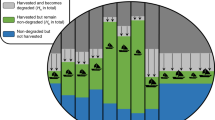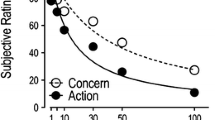Abstract
Environmentalists are often upset at the effect of discounting costs of future environmental damage, e.g., due to climate change. An often-overlooked message is that we should discount costs but also take into account the increase in the relative price of the ecosystem service endangered. The effect of discounting would thus be counteracted, and if the rate of price rise of the item was fast enough, it might even be reversed. The scarcity that leads to rising relative prices for the environmental good will also have direct effects on the discount rate itself. The magnitude of these effects depends on properties of the economy’s technology and on social preferences. We develop a simple model of the economy that illustrates how changes in crucial technology and preference parameters may affect both the discount rate and the rate of change of values of environmental goods. The combined effect of discounting and the change of values of environmental goods is more likely to be low – or even negative – the lower the growth rate of environmental quality (or the larger its decline rate), and the lower the elasticity of substitution between environmental quality and produced goods.
Similar content being viewed by others
References
Arrow KJ, Cline WR, Mäler K-G, Munasinghe M, Squitieri R, Stiglitz JE (1996) Intertemporal equity, discounting, and economic efficiency. In: Bruce JP, Lee H, Haites EF (eds) Climate Change 1995: economic and social dimensions – contribution of working group III to the second assessment report of the Intergovernmental Panel on Climate Change. Cambridge University Press, Cambridge, UK, pp 125–144
Azar C, Sterner T (1996) Discounting and distributional considerations in the context of global warming. Ecol Econ 19:169–184
Bank of England (2005) http://www.bankofengland.co.uk/statistics/index.htm. Accessed 20051215
Cline W (1992) The economics of global warming. Institute for International Economics, Washington, DC. ISBN 088132132X
Dasgupta P (2001) Human well-being and the natural environment, part III. Oxford University Press, Oxford
Dasgupta P, Heal G (1979) Economic theory and exhaustible resources. In: Cambridge economic handbooks
Fisher AC, Krutilla JV (1975) Resource conservation, environmental preservation, and the rate of discount. Q J Econ 89(3):358–370
Gerlagh R, van der Zwaan, BCC (2002) Long-term substitutability and man-made goods. J Environ Econ Manage 44:329–345
Halifax and Bank of Scotland (HBOS) 2005. Halifax house price index, http://www.hbosplc.com/economy/includes/historic_data_01.11.2005.xls. Accessed November 2005
Hasselmann K (1999) Intertemporal accounting of climate change – harmonising economic efficiency and climate stewardship. Clim Change 41:333–350
Hasselmann K, Hasselmann S, Giering R, Ocana V, Storch HV (1997) Sensitivity study of optimal CO2 emission paths using a simplified Structural Integrated Assessment Model (SIAM). Clim Change 37:345–386
Heal GM (1997) Discounting and climate change – an editorial comment. Clim Change 37:335–343
Horowitz JK (1996) Environmental policy under a nonmarket discount rate. Ecol Econ 16:73–78
Intergovernmental Panel on Climate Change (IPCC) (2001) Working group II assessment. http://www.grida.no/climate/ipcc_tar/wg2/411.htm). Accessed 20051215
Krutilla JV (1967) Conservation reconsidered. Am Econ Rev 57(4):777–786
Lind R (ed) (1982) Discounting for time and risk in energy policy. RFF Press, Resources for the Future, Washington, DC
Nordhaus WD (1997) Discounting in economics and climate change – an editorial comment. Clim Change 37:315–328
Philibert C (1999) The economics of climate change and the theory of discounting. Energy Policy 27:913–927
Philibert C (2006) Discounting the future. In: Pannell DJ, Schilizzi SGM (eds) Economics and the future. Edward Elgar, Cheltenham
Portney PR, Weyant JP (eds) (1999) Discounting and intergenerational equity. Resources for the Future, Washington, DC
Schelling TC (1995) Intergenerational discounting. Energy Policy 23:395–401
Shogren JF (2000) Speaking for citizens from the far distant future. Clim Change 45:489–491
Vennemo H (1997) On the discounted price of future environmental services. ECON, Oslo, Norway
Weitzman ML (1994) On the ‘environmental’ discount rate. J Environ Econ Manage 26:200–209
Weitzman ML (1998) Why the far-distant future should be discounted at its lowest possible rate. J Environ Econ Manage 36:201–208
Weitzman ML (2001) Gamma discounting. Am Econ Rev 91(1):260–271
Zerbe RO Jr (2004) Should moral sentiments be incorporated into benefit–cost analysis? An example of long-term discounting. Policy Sci 37:305–318
Author information
Authors and Affiliations
Corresponding author
Rights and permissions
About this article
Cite this article
Hoel, M., Sterner, T. Discounting and relative prices. Climatic Change 84, 265–280 (2007). https://doi.org/10.1007/s10584-007-9255-2
Received:
Accepted:
Published:
Issue Date:
DOI: https://doi.org/10.1007/s10584-007-9255-2




